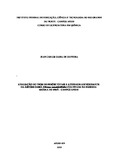Avaliação do teor de fenóis totais e atividade antioxidante da árvore Sabiá (Mimosa caesalpiniifolia) cultivada na fazenda escola do IFRN - Campus Apodi

Visualizar/
Data
2019-12-18Autor
Oliveira, Jean Carlos Gama de
http://lattes.cnpq.br/2659841504735548
Metadado
Mostrar registro completoResumo
The use of medicinal plants to treat health problems has been going on since ancient times and remains very current. With the passage of time and the advancement of technology, the
identification and the possibility of isolation of the substances responsible for phytotherapeutic
activity became easier. Thus, the objective of the present work was to evaluate the content of
phenolic compounds and antioxidant activity of extracts of the species Mimosa caesalpiniifolia,
popularly known as thrush. This work was motivated by the records of the use of their peels in
home medicine as a good treatment for bronchitis, in addition to presenting a healing aspect,
and other diseases. The extracts were obtained by immersion in three solvents with different
polarities (hexane, ethanol and water), being subsequently subjected to tests that showed
evidence of the presence of compounds with antioxidant activity. The quantification of total
phenols was done by the reaction of the extracts with Folin-ciocalteu reagent in a basic medium,
while the determination of antioxidant activity used 2 different methods: the first consisted of
inhibiting the DPPH radical activity by the action of the extract and the second was the ABTS·+
radical cation methodology was used. The best percentage yield in obtaining the crude extract
was observed in general in aqueous extracts, with emphasis on the aqueous extract of the leaves
with 11.24%. Regarding the total phenol content, the best result was related to the ethanolic
extract of the branches, which presented a value equal to 33.64 mgEAG/g extract, which is
considered a low value when compared to other plants with medicinal properties. Despite this,
the antioxidant tests showed excellent results for both methodologies. The DPPH reaction test
again highlights the ethanolic extract of the branches, with an IC50 value (inhibitory
concentration of 50% of the radical) equal to 7.08 mg/L and then the aqueous extract of the
barks with 9.38 mg/L. with the exception of hexane extracts, all showed activity close to the
positive standards used (vitamin C: 43 mg/L and Trolox: 4 mg/L). As for the test with ABTS·+,
the aqueous extracts of the branches and ethanolic of the branches (2658,57 µmol/L trolox/g)
and the barks (2314,81 µmol/L trolox/g) showed the best results. In addition, it was also
possible to observe a certain relationship between the concentration of phenols in the extracts
and the total antioxidant activity (ABTS·+).



